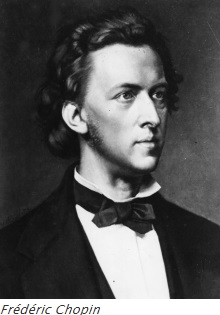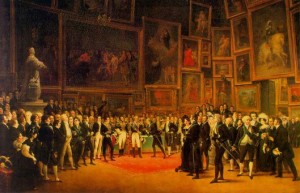Frédéric Chopin (1810-1849) was a Polish Romantic composer during the 19th century. He was born in Warsaw, but spent the majority of his music career in Paris where he performed, taught and composed for the piano. His most famous pieces include nocturnes, études, mazurkas, polonaises and waltzes.
Life
 Frédéric François Chopin was born in 1810 in Duchy of Warsaw to a French father and a Polish mother[1] . He spent most of his early life in Warsaw, receiving education at the Warsaw Lyceum where his father also worked[2]. He studied piano privately under Adalbert Żywny and later with Józef Elsner at the Warsaw Conservatory. Other composer‐pianists who greatly influenced Chopin include Václav Würfel, with whom Chopin studied thoroughbass and the organ; Józef Jawurek, an accomplished pianist and popular teacher; and Henryk Lentz, who instructed in organ and thoroughbass[3]. From an early age, it was apparent he was a child prodigy and his talents were very much in demand in aristocratic households[4]. In 1830, he left Poland for a concert, and the November Uprising later that year would prevent his return. He eventually arrived in Paris in 1831 where he would spend the remainder of his career. Although he never returned to his homeland, Chopin never lost that part of his identity: his music often invokes inspiration from the idealized image of Poland and is full of nostalgia for his homeland.
Frédéric François Chopin was born in 1810 in Duchy of Warsaw to a French father and a Polish mother[1] . He spent most of his early life in Warsaw, receiving education at the Warsaw Lyceum where his father also worked[2]. He studied piano privately under Adalbert Żywny and later with Józef Elsner at the Warsaw Conservatory. Other composer‐pianists who greatly influenced Chopin include Václav Würfel, with whom Chopin studied thoroughbass and the organ; Józef Jawurek, an accomplished pianist and popular teacher; and Henryk Lentz, who instructed in organ and thoroughbass[3]. From an early age, it was apparent he was a child prodigy and his talents were very much in demand in aristocratic households[4]. In 1830, he left Poland for a concert, and the November Uprising later that year would prevent his return. He eventually arrived in Paris in 1831 where he would spend the remainder of his career. Although he never returned to his homeland, Chopin never lost that part of his identity: his music often invokes inspiration from the idealized image of Poland and is full of nostalgia for his homeland.
Paris in the 1830s was the centre of Romanticism, and Chopin soon found himself surrounded by prominent Parisian artists and intellectuals, among them composer and virtuoso pianist Franz Liszt, painter Eugène Delacroix, cellist August Franchomme and German poet Heinrich Heine[5]. After a failed engagement to Maria Wodzińska in 1837[6], he became increasingly involved with writer George Sand (pen name of Aurore Dudevant), whom he met through his good friend Franz Liszt[7]. For eight years, Chopin spent his summers at Sand’s estate in Nohant, entertaining her guests[8]; these were his most productive years although his health worsened and his relationship with Sand also deteriorated. He was known as a fond piano teacher and a virtuoso performer who greatly preferred the salon to the concert hall[9]. When his relationship with Sand finally ended bitterly in 1847, he composed little more[10]. In 1848[11], he returned a final time to the concert scene touring in England and Scotland. He died of tuberculosis in Paris at the age of thirty-nine[12].
Music, Performance & Compositional Style
Chopin is known, first and foremost, as a legendary virtuoso pianist. Unlike most composer-pianists at the time, he greatly preferred the intimate setting of the French salon to the public concert hall. These salons allowed for gatherings of professional and amateur musicians alike. In Europe and America, these salon settings became widely popular, and still remain one of the most popular forms of classical music performance[13].
Chopin is well-known for his improvisation skills as well as his playing style which possessed a “lyrical, flowing quality, the remarkable delicacy of his touch, and the subtlety of his dynamic shading and pedaling”[14]. The rise in popularity of the piano in the 19th century helped shaped the cultural scene surrounding the instrument: a series of technological developments and manufacturing standards eventually led the piano into homes of middle- and upper-classes as a universal fixture[15]. Chopin’s reputation was built on the mastery of this one instrument[16], and the new improvements on the piano at the time permitted great virtuosity.
Chopin’s early musical compositions from Warsaw, including his polonaises, rondos and variations, reflect the influences of Hummel, Weber, and Kalkbrenner[17] in the stile brillante tradition. His piano concertos marked the end of his apprenticeship, and with the composition of Études Op. 10 in 1832, he gained his own unique musical style. Much of Chopin’s music is also greatly influenced by Bach in his use of a strong harmonic base with linear-melodic elements overtop. His use of form, particularly the ternary form (ABA), also reflects his preference for formal schemes. Chopin’s nocturnes famously showcase the operatic bel canto style of early 19th century opera[18]. Much of his music is also influenced by his roots: both his polonaises and mazurkas are native Polish dance forms.
Innovations & Legacy
“Everything must be made to sing.”
Chopin’s music has become a staple in piano repertoire. His music is deeply rooted in the Romantic style: his lyricism, above all, shines in all his pieces. He famously said to his pupils, “Everything must be made to sing”[19]. His exploited the new and improved instrument with his use of delicate trills, grace notes and runs, all sustained by chords in the bassline with the pedal. His singing melodies feature most prominently in his meditative nocturnes. His extreme mastery of the piano has led to his being credited with originating the modern piano style[20].
Like other Romantic composers, Chopin also followed in the wave of interest in folklore and nationalism: he composed many mazurkas and polonaises rooted from his homeland, Poland. As music moved gradually from the church to concert hall in the early 19th century, orchestras gradually grew to compensate. As a result, new orchestral forms and sounds were allowed in orchestral music. Chopin did not venture far into this field; although he did write two piano concertos, his focus was always on the piano. Huneker also credits Chopin for his innovations in the prelude, the waltz, the ballade and the scherzo[21].
Chopin, along with Liszt and Debussy, is also credited for developing the concert étude. Unlike previous studies whose sole purpose was the study of technical skills, the étude became virtuosic performance pieces. Chopin’s music also calls for the use of rubato ((It.) robbed time[22]), in which certain liberties are taken with the rhythm without upsetting the basic beat. Schonberg claims Chopin explained rubato as: “The left hand is the conductor, it must not wave or lose ground; do with the right hand what you will and can”[23].
Major Works
Two piano concertos • Piano music, including four ballades, three sonatas, preludes, études, mazurkas, polonaises, scherzos, waltzes, impromptus, and nocturnes • Chamber music, all with piano • Songs[24]
[1] The Enjoyment of Music 11th edition 223
[2] Bauer 2
[3] Goldberg 107
[4] The Oxford Companion to Music: Chopin, Fryderyk [Frédéric] (Franciszek)
[5] Goldberg 439
[6] The Oxford Companion to Music
[7] The Oxford Companion to Music, Goldberg 439
[8] The Enjoyment of Music 11th edition 223
[9] Goldberg 439
[10] The Oxford Companion to Music
[11] Huneker 65
[12] The Enjoyment of Music 11th edition 223
[13] The Enjoyment of Music 221
[14] The Oxford Companion to Music
[15] The Enjoyment of Music: Essential Listening Second Edition 201-2
[16] Goldberg 439
[17] The Oxford Companion to Music
[18] The Oxford Companion to Music
[19] The Enjoyment of Music: Essential Listening Second Edition 204
[20] The Enjoyment of Music: Essential Listening Second Edition 203
[21] Huneker
[22] The Concise Oxford Dictionary of Music: rubato
[23] Bauer 15
[24] The Enjoyment of Music: Essential Listening Second Edition 203
